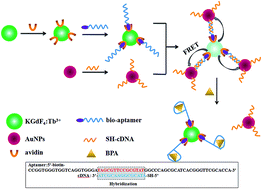Fluorescence resonance energy transfer-based aptamer biosensors for bisphenol A using lanthanide-doped KGdF4 nanoparticles
Abstract
We report a method for trace detection of bisphenol A (BPA) based on fluorescence resonance energy transfer (FRET) between lanthanide-doped KGdF4 nanoparticles (KGdF4:Tb3+ NPs) as a donor, and gold nanoparticles (AuNPs) that act as an acceptor. The KGdF4:Tb3+ NPs were modified with an aptamer recognizing BPA, and AuNPs were modified with the complementary DNA (cDNA) of the aptamer. The donor–acceptor pair was fabricated by hybridizing the aptamers and their cDNA. Thus, fluorescence of the KGdF4:Tb3+ NPs could be quenched due to the good overlap between the KGdF4:Tb3+ NP fluorescence emission and the AuNP absorption spectrum. However, on addition of BPA, the aptamers preferentially bound to BPA, forming KGdF4:Tb3+ NP–aptamer–BPA complexes. As a result, the FRET was disrupted, and the fluorescence was restored. The recovered fluorescence of the KGdF4:Tb3+ NPs was linearly proportional to the concentration of BPA in the range of 0.5 to 100 ng mL−1, with detection limits as low as 0.16 ng mL−1. The assay was applied to real samples, and the results were consistent with the results obtained using high performance liquid chromatography (HPLC) methods. We presume that this strategy can be extended to the detection of other contaminants by simply substituting the aptamer.


 Please wait while we load your content...
Please wait while we load your content...